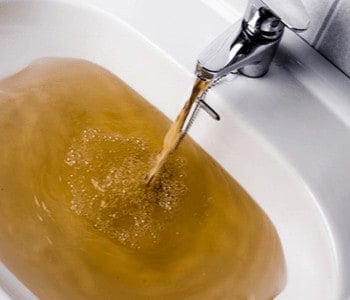
If your tap water looks like weak tea and smells a bit musty, you might be dealing with tannins — natural compounds from decaying vegetation that sneak into shallow wells.
While they’re not harmful, they can make your water taste funky, stain your laundry, and clog up filtration systems if left unchecked.
The good news? There are proven ways to remove tannins from well water — and we’ll break down the best options based on what actually works.
⚡ Quick Take
- 🍂 Tannins = Nature’s tea stains – Harmless, but unappetizing
- 👃 They cause funky taste and yellow tint – Especially in shallow wells
- 🧪 Testing first is key – Tannins often hide other issues like iron
- 🚿 Filtration is the fix – Ion exchange, RO, or nanofiltration all work
- 📉 Not all filters remove tannins – So match your system to your water
🍂 What Are Tannins, Anyway?

Tannins are natural organic compounds found in decaying plant matter — think leaves, bark, and peaty soil. While they’re great in wine and tea, they’re not so charming in your tap water.
When tannins seep into shallow wells or surface-fed aquifers, they tint your water yellow or brown, and often leave a bitter or earthy aftertaste. While not dangerous to your health, they can be annoying — especially if you like your laundry white and your water clear.
💡 Good to Know: Tannins can bind with iron and interfere with iron filters — which is why testing is crucial before choosing a filtration system.
🌿 Where Do Tannins Come From?

If your water looks like weak tea, it’s likely packed with tannins — natural compounds that sneak into your well from decaying plant material. These earthy invaders aren’t toxic, but they sure can make your water taste and smell funky. Here’s a breakdown of the common culprits behind that yellow tint:
| 🌱 Source | 😬 What It Does | 📍 Where It Happens |
|---|---|---|
| Decaying vegetation | Turns water brown or yellow ☕ | Swamps, forests, wet lowlands |
| Peaty or marshy soil | Adds earthy taste and musty odor 🌾 | Shallow or older wells |
| Surface water runoff | Flushes organic debris into the well 💧 | After storms or snowmelt |
| Tannin + iron mix | Clogs up iron filters and softeners 🧲 | Common in older plumbing systems |
While tannins won’t make you sick, they’re often a warning sign your well is picking up more than just water — and they love to tag-team with iron and sediment. Fortunately, they’re easy to treat once you pinpoint the source.
☣️ Are Tannins in Drinking Water Harmful?

Tannins might look nasty and taste even worse — but the good news? On their own, they’re not considered dangerous to your health.
Still, that doesn’t mean you should ignore them…
👎 Why Tannins Can Be a Problem
- They hide nastier stuff – Tannins can mask the presence of bacteria, sediment, or even parasites.
- They wreak havoc on laundry – White clothes and tannin-rich water? Say goodbye to bright towels.
- They stain plumbing – Expect yellow marks on tubs, sinks, and toilets over time.
- They mess with filters – Tannins can reduce the effectiveness of iron filters and even soften resin beds.
💡 Good to Know: Tannin-heavy water tends to be more acidic. That means it’s tougher on pipes, fixtures, and anything metal in your plumbing system.
🔬 How Do I Know If It’s Tannins?

Tannins can look a lot like iron or sediment — which makes it tough to tell what’s really turning your water brown. The fix? A simple test.
Let’s walk through how to spot tannins versus other common well water issues.
🧪 Don’t Guess — Test First
Brown or yellow water isn’t always caused by tannins. Iron, manganese, or even algae can mimic the look. Start with a basic visual test, then confirm with lab analysis if needed.
👀 Tannin Troubleshooting Table
| 🧪 Test | 🔍 What to Look For | 💡 What It Means |
|---|---|---|
| 💧 Let water sit overnight in a jar | Water stays discolored | Likely tannins – color won’t settle out |
| 🪣 Sediment settles to bottom | Clear top, murky bottom | Likely iron, manganese, or clay particles |
| 👃 Smell the water | Musty or swampy odor | Tannins or organic matter |
| 🧪 Send sample to lab | Comprehensive report on water chemistry | Confirms tannins, pH, hardness & more |
🧠 Want Real Answers?
DIY is helpful, but a certified lab like SimpleLab’s Tap Score gives you full clarity — including tannins, pH, hardness, and other problem contaminants. It’s the smart first step before choosing a system.
🔬 How Do I Know If It’s Tannins?

Brown or yellow water doesn’t always mean tannins. Iron, sediment, or even algae can look suspiciously similar. But with a few simple tests — and maybe a lab kit — you’ll know for sure.
🧪 Rule Out the Usual Suspects
Tannins don’t settle, stain like rust, or smell like sulfur. If your water stays tinted no matter how long it sits, you’re probably dealing with organic tannins — not metallic minerals. But don’t guess. Testing brings clarity.
| 🔬 Test | 👀 What to Watch For | 💡 What It Might Mean |
|---|---|---|
| 🫙 Let it sit overnight | Color stays evenly tinted | Probably tannins – they don’t settle |
| ⏬ Sediment settles to bottom | Clear water on top | Iron or clay particles, not tannins |
| 👃 Smell test | Earthy or musty odor | Often tannins or decaying organics |
| 🧪 Certified lab test | Full breakdown of your water chemistry | Confirms tannins, pH, metals, and more |
🧠 When in Doubt, Test It Out
DIY jar tests are handy, but a lab kit is the gold standard. We recommend a full lab report — to tests for tannins and the usual suspects like iron, manganese, and pH. No guessing, no wasted money on the wrong filter.
✅ Which Water Filters Actually Remove Tannins?

Not every water filter is built to handle tannins — and choosing the wrong system can leave your water tasting just as earthy as before. The right solution depends on your water chemistry, tannin levels, and what else is in your well.
Here’s a side-by-side look at the most effective treatment options and what they actually do best 👇
| 🔧 Filter Type | 🟤 Removes Tannins? | 💡 Best For |
|---|---|---|
| Ion Exchange Softener | ✅ Yes (with tannin resin) | Great for wells with both hardness and tannins — [best paired with the right resin system |
| Reverse Osmosis (RO) | ✅ At the tap | Excellent for drinking water – removes tannins and most other contaminants |
| Oxidation Filter + Carbon | ☑️ Sometimes | Best for iron-heavy water where tannins are also present |
| Nanofiltration | ✅ Yes | Effective but pricey — better for high-tannin or specialty use cases |
| Activated Carbon Filter | 🚫 Not reliably | Good support option after oxidation — but not ideal on its own |
Each system has its pros and tradeoffs — and not all of them are necessary for every home. If your water is mostly clear but tastes off, a simple RO unit might do the trick. But for cloudy, tannin-rich well water? A dedicated whole-house tannin system is usually the most effective long-term fix.
✅ Final Thoughts
Tannins in well water aren’t dangerous — but they sure can be annoying. From yellow laundry to bitter-tasting water — these natural compounds are more than just a cosmetic issue.
The good news? You’ve got options. Whether you go with a tannin-specific water softener, a reverse osmosis unit, or a multi-stage whole-house system, there’s a fix that fits both your budget and your water chemistry.
💡 Pro Tip: If you’re unsure where to start, a basic water test can help pinpoint the cause — and save you money by matching you with the right solution the first time.
With the right setup in place, you can finally enjoy water that looks clean, tastes crisp, and won’t turn your white towels beige. ☕🧺💧
 126 people found this helpful. Was this guide helpful to you?
126 people found this helpful. Was this guide helpful to you? 

